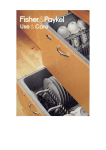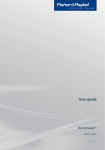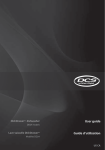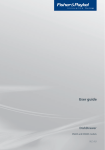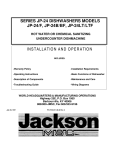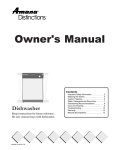Download Fisher & Paykel 526984C User's Manual
Transcript
CONTENTS Introduction 2 Accessories 3 Important Safety Instructions 4 Control Functions Primary Control Buttons Lock Electronic Display Secondary Control Panel 8 8 9 10 12 Operating Instructions 13 Usage DishDrawer Accessories Purpose of Each Insert 14 14 14 DishDrawer Loading Loading Pattern for 10 Place Settings 16 18 Detergent & Rinse Agent Dispenser Detergent Compartments Rinse Agent Dispenser 19 19 20 Option Adjustment Mode Rinse Agent Setting Auto Power Water Pressure 21 21 22 22 Wash Programs 23 Installation of Upper Kickstrip 24 Care Guide 25 User Maintenance Instruction Cleaning the DishDrawer Cleaning the Drain Filter, Spray Arm, Filter Plate & Motor Assembly Vacation Time 26 26 26 27 Problem Solver 28 Fault Code Displays 32 DishDrawer Warranty 35 1 INTRODUCTION Thank you and congratulations for making the wise decision in purchasing your Fisher & Paykel DishDrawer. Every care has been taken in designing and manufacturing your appliance. We are sure that you will enjoy using your DishDrawer and will soon appreciate its many benefits. We wish you many years of satisfying use. Unique Features of Your DishDrawer By now you will be aware that Fisher & Paykel's DishDrawer is a unique dishwasher, which offers benefits no other dishwasher can. The DishDrawer takes the everyday kitchen drawer - long recognised as the most efficient, easy to access storage system in the kitchen - and turns it into the most advanced dishwasher in the world. If you have chosen a double DishDrawer, or more than one single DishDrawer, you will have totally separate, independently operated washing units, introducing loading and washing possibilities that have never before been possible. Now you can treat precious glassware to a delicate wash and give pots and pans the heavy duty treatment - all at the same time. The Clutter-Free Counter Top Becomes A Reality Now it really is possible to keep your counter top free from everyday clutter like tall glasses and awkward serving dishes. The double DishDrawer's spacious configuration gives you many new ways to load your machine - and use it. Used cleverly, two DishDrawers can even provide extra kitchen storage. Use clean dishes directly from one drawer and load them back into the other drawer when dirty. Design Your Own Rack System With flexible, interchangable inserts the DishDrawer can be arranged to accommodate the way you live and the dishes you use most often. Inserts are easy to remove so it is easy to change your layout as your daily needs change. If you have two DishDrawers, you can arrange one drawer for all your lightly soiled cups, saucers and fine glassware - including long-stemmed glasses - and wash them using a delicate cycle. Set up your other drawer for your more robust, heavily-soiled items like plates, pots and pans. Inserts can easily be removed completely to fit awkward preparation or serving dishes. 2 The Guilt-Free Small Load All DishDrawer models make the small, guilt-free load a reality. The DishDrawer minimizes water and energy consumption with each drawer using less than half the water of a conventional dishwasher. By washing smaller loads more frequently, you need never run out of clean dishes. Gentler Introduction of Detergent The DishDrawer's innovative detergent dispenser thoroughly pre-mixes water with detergent before it is introduced into the drawer, so your delicate dishes are protected from "detergent burn". Precise markings inside the dispenser ensure you never use too much or too little detergent for each program. Big On the Inside Each DishDrawer has been carefully designed to give you more usable space than ever before. Each DishDrawer can accommodate 12 large dinner plates up to 11.4" in diameter. A deeper drawer design means large plates can be loaded into the drawer while cups and glasses can be safely stacked into the two levels. Fisher & Paykel strongly recommends that you read the information contained in this Use & Care Manual before using the DishDrawer. ACCESSORIES Each DishDrawer is supplied with the following: · Basket · Cutlery Basket · Mega Rack · Drain Filter Access Panel · Plate Insert 3 IMPORTANT SAFETY INSTRUCTIONS Warning - When using your DishDrawer, follow basic precautions, including the following: For your safety the information in this manual must be followed to minimize the risk of fire or explosion or to prevent property damage, personal injury or loss of life. Please read all instructions before operating the DishDrawer. Use the DishDrawer only for its intended function as described in this Use and Care manual. Use only detergents or wetting agents recommended for use in a dishwasher and keep them out of reach of children. Do not touch the heater plate during or immediately after use. Do not operate your DishDrawer unless all the enclosure panels are properly in place. Do not tamper with the controls. Do not abuse, sit on, stand in or on the drawer or dish rack of the DishDrawer. When loading items to be washed 1. Locate sharp items so that they are not likely to damage the lid seal and 2. Load sharp knives with the handles up to reduce the risk of cut type injuries. 4 IMPORTANT SAFETY INSTRUCTIONS To reduce the risk of injury, do not allow children to play in or on the DishDrawer. Under certain conditions hydrogen gas may be produced in a hot water heater system that has not been used for two weeks or more. HYDROGEN GAS IS EXPLOSIVE. If the hot water system has not been used for such a period, before using the dishwasher, turn on all hot water faucets and let the water flow from each for several minutes. This will release any accumulated hydrogen gas. As gas is flammable, do not smoke or use an open flame during this time. Remove the door to the washing compartment when removing an old dishwasher from service or discarding it. Installation This DishDrawer must be installed and located in accordance with the Installation Instructions before it is used. If you did not receive an Installation Instruction book with your DishDrawer, you can obtain one by calling toll free 1 888 9 FNP USA (1 888 9 367 872). Installation and service must be performed by a qualified technician. This appliance must be grounded. In the event of a malfunction or breakdown, grounding will reduce the risk of electric shock by providing a path of least resistance for electric current. This appliance is equipped with a cord having an equipment - grounding conductor and a grounding plug. The plug must be plugged into an appropriate outlet that is installed and grounded in accordance with all local codes and ordinances. WARNING - Improper connection of the equipment - grounding conductor can result in a risk of electric shock. Check with a qualified electrician or service representative if you are in doubt whether the appliance is properly grounded. Do not modify the plug provided with the appliance; if it will not fit the outlet, have a proper outlet installed by a qualified electrician. Ensure the DishDrawer is secured to the floor or adjacent joinery using the brackets provided. Failure to do so may result in an unstable product, which may cause damage or injury. 5 IMPORTANT SAFETY INSTRUCTIONS Do not operate this appliance if it is damaged, malfunctioning, partially disassembled or has missing or broken parts, including a damaged cord or plug. Do not store or use gasoline, or other flammable vapors and liquids in the vicinity of the DishDrawer. Connect to a properly rated, protected and sized power supply circuit to avoid electrical overload. Make sure that the cord is located so that it will not be stepped on, tripped over or otherwise subject to damage or stress. Do not install or store the DishDrawer where it will be exposed to temperatures below freezing or exposed to weather. Do not use an extension cord or a portable electrical outlet device (e.g. multi socket outlet box) to connect the DishDrawer to the power supply. Maintenance Do not repair or replace any part of the appliance or attempt any servicing unless specifically recommended in this Use and Care Manual. We recommend that you call a Fisher & Paykel Authorized Service Agent. Keep the floor around your appliance clean and dry to reduce the possibility of slipping. Keep the area around / underneath your appliance free from the accumulation of combustible materials, such as lint, paper, rags and chemicals. When cleaning the underside of the filter plate, care must be taken on the sharp outer edge to avoid the risk of cut type injuries. Operational Under no circumstances should you open the drawer whilst the DishDrawer is in operation. Always use the Start / Pause button to pause and wait until you hear the two additional beeps before opening the drawer. 6 IMPORTANT SAFETY INSTRUCTIONS The DishDrawer must be used with the motor assembly, filter plate, drain filter and spray arm correctly in place. When disconnecting the appliance pull the plug rather than the cord or junction of cord to avoid damage. Household appliances are not intended to be played with by children. Children or persons with a disability that may limit their ability to use the appliance, should have a competent person instruct them in its use. This person should be satisfied that they can then use the appliance without danger to themselves or their surroundings. Close supervision is necessary if this appliance is used by or near children. Do not allow children to play inside, on or with this appliance or any discarded appliance. The DishDrawer is designed for washing normal household utensils. Items that are contaminated by gasoline, paint, steel or iron debris, corrosive, acidic or alkaline chemicals are not to be washed in the DishDrawer. If the DishDrawer is not being used for long periods of time, turn the power and water supply to the DishDrawer off. It is important that the Use & Care Manual should be retained with the appliance for future reference. Should the appliance be sold or transferred to another owner, always ensure that the Use & Care manual is left with the appliance in order that the new owner can familiarize themselves with the appliance and the relevant warnings. SAVE THESE INSTRUCTIONS 7 CONTROL FUNCTIONS Where there are two DishDrawers in the one cabinet, each drawer has its own control panel and can run independently of the other. Figure 1 - Primary Control Panel Primary Control Buttons Power The Power button, it turns the DishDrawer on and off. On After pressing the Power button the Electronic Display will show: · A green background. · The number of minutes from the last wash program used. · The min symbol flashing. Off To terminate a wash program, press the Power button. Any remaining water in the DishDrawer will be pumped out. At the finish of a wash program the DishDrawer will stop. The Electronic Display will have no background light. The smiley face symbol and 00 will be displayed. 8 Start / Pause This button has a number of functions. It serves to: · Start the DishDrawer, once the desired wash program has been selected. · Interrupt the wash program while in operation. When pausing the DishDrawer, wait until you have heard two additional beeps before you open the drawer, allowing the lid seal to deflate. While in the pause mode, the electronic display will be green, the min symbol will flash and the "smiley face" symbol will disappear. · Restart the DishDrawer after being paused. You may notice a delay after the Start / Pause has been pressed. During this time the lid seal will be inflating. · One Button Start. This starts the DishDrawer and will run the last wash program used, excluding Delay Start if used in the previous wash. · Initiates the Delay Start. NOTE: Under no circumstances do we recommend that you open the DishDrawer while in operation unless you have pressed the Start / Pause button. If the drawer is opened during the wash program, there is a possibility of getting wet, burnt, or damaging the DishDrawer. There are safety mechanisms in place to stop the DishDrawer if it is opened. If Fault Code U2 Appears: The fault code U2 will be displayed if the drawer is opened during operation. To remove this fault code, press Power. Ensure the drawer is closed. The DishDrawer will now be ready to start from the beginning of the wash program. You may have to add more detergent in the dispenser and then press the Start / Pause button to start the DishDrawer. The DishDrawer will not restart where it was interrupted after a U2 fault. Lock The Lock function disables all the other functions on the DishDrawer. This function is useful when cleaning the control panel and can also prevent children from turning the DishDrawer on or off accidentally. This button can be used when the DishDrawer is in operation and will remain active until the Lock is deactivated. To activate this function, press and hold the Lock button until the key symbol at the bottom of the Electronic Display appears continuously and is no longer blinking. All the other buttons are now inactive. To deactivate this function, press and hold the Lock button until the key symbol in the Electronic Display disappears. 9 Figure 2 - Electronic Display showing the lock mode Electronic Display The Electronic Display has a number of functions. It shows: · The time for each wash program selected. Each time you change the wash program, the number in the Electronic Display will change to indicate the approximate duration of each wash program. The min symbol will flash until a wash program has started. · Time remaining in the wash program. This is shown with the background in green. When the wash program has started, it will count down in one minute increments, represented by the min symbol. The min symbol will remain and the smiley face symbol will flash. · Delay Start. An orange background is shown. It will count down in one hour increments when delay start has been selected. The HRS DELAY symbol represents the number of hours before the DishDrawer starts. · Lock has been activated. The key symbol will be shown at the bottom of the Electronic Display. · A Fault Code. In the unlikely event of a failure, a fault code is displayed and the background is red. (For more information Refer to Section on Fault Code Displays.) · Water heating is in progress. The HE symbol is displayed. This means that water heating is in progress due to incoming water being too cold, a drop in temperature through the DishDrawer being opened during the wash program, or the correct wash temperature not having been reached. The wash program times on the Electronic Display are based on inlet water temperatures at 120°F. 10 Figure 3 - Electronic Display showing Time Remaining in a wash program Figure 4 - Electronic Display showing a Fault Code Delay Start This feature allows you to delay the start of the wash program from one to twelve hours. It is useful if you want to take advantage of off peak power rates, (Check with your local Electrical Utility if this is available), or if you wish to start the DishDrawer at a later time. To Activate Delay Start 1. Ensure the drawer is closed. 2. Press and hold the Start / Pause button until the background color of the Electronic Display turns orange. 3. Hold or press the Start / Pause button and the time will increase in increments of one hour. You will also hear a beep for each hour passed. 4. Release the button when the desired time has been reached. The DishDrawer will start automatically when the time has elapsed. To cancel Delay Start, press the Power button or keep pressing the Start / Pause until it passes the 12 hours. The HRS DELAY will disappear on the Electronic Display and the background will be green. 11 Figure 5 - Electronic Display in Delay Start Mode Secondary Control Panel Wash Programs One advantage of two independent DishDrawers is that you can divide the dish loads according to need. For example, you can wash pots or heavily soiled items on a Heavy Plus program in one drawer while washing china or glassware on a Delicate Eco Save program in the other drawer. When selecting a wash program ensure the control panel inside the drawer is clean and dry. If not, wipe with a clean dry cloth. Program Figure 6 - Secondary Control Panel This button advances through the wash programs in sequence. The wash program indicator light can be either red or green. If the light above the selected wash program is red, it indicates that you have selected a Plus program. If the light above the wash program is green, an Eco Save program has been chosen. Rinse Rinse can be used for dirty dishes that need rinsing and will be washed later. The Eco Save function has no effect on the Rinse program. Heavy Wash This wash is recommended for heavily soiled dishes such as roasting dishes, pots and dishes with baked on soil. Normal Wash This wash can be used for normal everyday dishes. Fast Wash This wash is designed for non greasy lightly soiled dishes. Delicate Wash This wash is a gentle program for lightly soiled and heat sensitive crockery. Program Modifier (Red or Green) Plus Programs (Red) The Plus Programs use higher wash temperatures and longer wash times to give enhanced wash and dry performance. The light above the wash program is red to indicate that this option has been chosen. Eco Save (Green) Eco Save saves on energy. It achieves this by using lower wash temperatures and shorter times and because of this, dry performance may be compromised. 12 OPERATING INSTRUCTIONS 1. Ensure the filter plate and drain filter is clean and free of food debris. Check the drain filter is flush with the filter plate and the spray arm is correctly on the impeller. 2. Check there is rinse agent in the dispenser. 3. Remove all food scraps from the dishes. 4. Load the dishes. Overcrowding the DishDrawer may lead to poor wash performance. Ensure there are no items blocking the spray arm path. 5. Pour detergent into the detergent dispenser, then close the dispenser door. Use the steps on the detergent dispenser as a guide to the correct amount of detergent to use. Where the detergent manufacturer has made recommendations on quantities, we suggest you follow their instruction. 6. Select the wash program on the secondary control panel. Touch the Program button until the desired wash program light shows on the panel. The wash program has now been selected. 7. Select Eco Save (Optional) If you would like the wash program to use less energy and time, Eco Save should be selected by touching this button. The wash program light will be green. 8. Close the drawer. 9. Delay Start (Optional). If you wish to delay the start time, hold the Start / Pause button until the Electronic Display background has changed to an orange color and the HRS DELAY symbol comes on. Select the delay time required and the DishDrawer will start when the time has elapsed. 10. Start the Wash Program. Press the Start / Pause button to start the DishDrawer. To pause the DishDrawer, press the Start / Pause button and wait for the two additional beeps before opening. The min symbol displayed in the Electronic Display will flash, and the smiley face symbol will disappear. 11. At the end of the program, the display will show no background light. The symbols 00 and the "smiley face" will be displayed on the Electronic Display. The DishDrawer will beep six times to let you know that it has finished. At the end of a wash program it is normal to find some water in the drain filter area and the drying fan will be on for a period of time or until the drawer is opened. While the fan continues to be on, it assists with the drying and uses negligible amounts of energy. In the event of a power failure, the DishDrawer will stop until the supply power is resumed. It will drain the water in the DishDrawer and restart in the same part of the wash program it was in when the power failed. 13 USAGE DishDrawerTM Accessories The basket is the basic insert DishDrawer requires to wash dishes. The inserts and racks can be added or removed to suit your individual needs. If you have two DishDrawers, some of the parts are interchangable between the two drawers. For example you can combine the two Mega Racks into one drawer and wash all cups and glasses, leaving the other drawer for plates and larger items. Figure 7 - Recommended Positions for Inserts & Racks Purpose of Each Insert Basket This is the most basic piece and it is essential for this to be carefully placed into the DishDrawer first. It holds some of the inserts in place and keeps the dishes above the spray arm so it can rotate and spray water onto the dishes. Drain Filter Access Panel The drain filter access panel is designed to give access to the drain filter. The purpose of this insert is to prevent objects from touching the base of the DishDrawer and stopping the rotation of the spray arm, but still giving access to the drain filter. Figure 8 - Basket & Drain Filter Access Panel Cutlery Basket The cutlery basket is removable and ideally should sit over the opening of the drain filter in the front right hand side of the drawer. For maximum wash performance the ovals slots should face the middle of the drawer. Individual pieces of cutlery, like knives or spoons, can be placed in the oval slots for convenience. Figure 9 - Cutlery Basket 14 Plate Insert The plate insert can be installed to the left or the right side of the basket. This insert is capable of supporting plates and bowls. 1 Mega Rack The Mega Rack can be installed to the left or the right side of the basket. If you want to wash wine glasses, this rack should be installed on the left side. This rack is designed to hold a combination of glasses, cups and small plates. To install this rack, place the outer legs of this rack on the top of the basket, hook into the mid section under the middle wire and clip the Mega Rack to the side of the basket. When correctly installed, the Mega Rack should not feel loose. It is important to assemble this rack correctly to minimize the chance of obstructing the spray arm. 15 2 Figure 10 - Accessories in the DishDrawer Key 1. Mega Rack 2. Plate Insert DISHDRAWERTM LOADING Baskets · · · · · · · · Scrape off all food scraps and remove any bones, crusts, toothpicks and any similar items. Overloading can lead to poorly washed dishes. Small light items should be placed soiled side down on the basket. Plates, bowls and saucers can be slotted into spaces provided. Long kitchen utensils can be laid flat on the cup racks. If there are no inserts in the basket, large bowls and pots can be placed flat in the DishDrawer. Ensure no items touch or protrude above the top of the drawer as you close it, as damage to the DishDrawer and dishware may occur. Locate sharp items so they cannot damage the lid seal. Particular attention must be paid to knives to ensure they do not dislodge during the wash, to prevent injury to yourself or the DishDrawer. Please note that the DishDrawer basket and its inserts are not designed to be lifted out of the DishDrawer while loaded with dishes. Figure 11 Figure 12 Examples of how we recommend you load your DishDrawer ü ü û û Figure 13 Figure 14 Examples of how NOT to load your DishDrawer 16 Cup Racks Cups, glasses and kitchen utensils can be placed on both sides of the cups inserts. For best wash performance ensure there are no large items blocking the wash water from reaching the cup racks. See Figures 11 and 12 for the recommended method of loading the DishDrawer. Wine glasses can be supported on the left hand cup racks if used in conjunction with the Mega Rack. See Figure 15. Cutlery Baskets · · · For best wash performance mix spoons, knives and forks within each section of the basket. Alternate between handles up and down to prevent nesting and ensure water circulates freely. We recommend that sharp utensils should have their handles facing up, to reduce the risk of cut type injuries. Keep stainless steel from touching silver - mixing these metals can stain cutlery. Figure 15 Recommended Placement for Wine Glasses Spray Arms · · Ensure there are no items blocking the path of the spray arm. Check that no items have slipped through the cutlery basket. 17 Figure 16 - Cutlery Basket Recommended Loading Pattern for 10 Place Settings Top Basket Figure 17 Bottom Basket Figure 18 Cutlery Basket Figure 19 Detergent Quantities We recommend the use of 5g of detergent in the pre-rinse compartment and 10g in the main wash compartment. 18 DETERGENT AND RINSE AGENT DISPENSER The detergent and rinse agent dispenser is located on the inside of the DishDrawer. 1 Detergent Compartments There are two compartments - one for pre-wash detergent and the other for the main wash detergent. The pre-wash compartment is the smaller. The size of the compartments are a guide to detergent usage. The main wash compartment has steps on the side, these can be used as a guide for how much detergent to use. The lowest step is equivalent to one teaspoon when the detergent is level with this step, the middle step is equivalent to two teaspoons and the top step is equivalent to three teaspoons. The detergent dispenser is designed for use with powdered detergent, however if liquid detergents are used we do not recommend the Delay Start function be used in conjunction with it. Tablet detergents are not suitable to be used in the DishDrawer. 2 3 Figure 20 - Detergent & Rinse Agent Dispenser Key 1. Latch 2. Rinse Agent Indicator Light 3. Rinse Agent Plug To Load the Detergent Dispenser · · · · Press the latch down and the door will open. Pour detergent - For heavily soiled items, extra detergent can be placed in the pre-wash detergent compartment. - No detergent is needed for the Rinse program. After filling the compartment(s), close the dispenser door until it clicks shut. The detergent will automatically be released into the DishDrawer during the wash program. Important Only use detergent recommended for domestic automatic dishwashers. Handwashing liquids, soap, laundry detergents or disinfectant will damage the DishDrawer. Never sprinkle or pour detergent directly onto any item in the DishDrawer. WARNING Dishwasher detergents are strongly alkaline. They can be dangerous if swallowed. Avoid contact with skin and eyes. Keep children and infirm person(s) away from the DishDrawer when the drawer is open. 19 3 2 1 Figure 21 Detergent & Rinse Agent Dispenser Key 1. Latch 2. Main Wash Compartment 3. Pre Wash Compartment Rinse Agent Dispenser Rinse agent gives a streak free sparkling clean look to glass and chinaware. It speeds up drying and helps prevent metal from tarnishing. We highly recommend that you regularly use liquid rinse agent to give the best drying results. For best drying results, periodically check the rinse agent dispenser to see if it needs filling and fill when empty. The rinse agent dispenser is on the inside of the drawer, located underneath the detergent dispenser. The dispenser holds approximately 1.7 fluid oz of rinse agent. Figure 22 - Filling the Rinse Agent Dispenser To Load the Rinse Agent Dispenser · · · · · Turn the plug counter clockwise, about one eighth of a turn and remove. Pour the rinse agent into the circular opening. Take care not to spill rinse agent into the drawer. Wipe any overflow to prevent excess foaming. Fit the plug back into the original position. Rinse Agent Indicator Light · · If the rinse agent indicator light is red, then there is little or no rinse agent left in the dispenser. Rinse agent should be added into the dispenser. If the rinse agent window is black, there is enough rinse agent for the wash. How Much Rinse Agent to Use The regulator may need adjusting to suit your water conditions. The lowest setting is 1 and the highest is 5. · If your dishes have white streaks, or there is excessive foam in the DishDrawer, reduce the setting. · If your dishes have water marks, or if flecks are left on glasses after drying, increase the setting. 20 OPTION ADJUSTMENT MODE After using the DishDrawer, you may want to change some of the preset options to suit your needs. The following settings can be changed: Rinse Agent Auto Power Water Pressure To make these changes it is necessary to enter into the Option Adjustment Mode. To Enter Option Adjustment Mode Press Power to turn the DishDrawer on. The electronic display will be green. Press and hold the Program and Eco Save buttons simultaneously for five seconds. When the buttons have been pressed correctly the DishDrawer will emit one long beep. Release the two buttons. The electronic display will be red and the secondary control panel light(s) will be orange. See below for further details. Use the buttons on the primary and secondary control panel to make your changes to the pre set options. These are explained below. Once you have made these changes, press the Power button to return to the Normal mode. The DishDrawer will save these changes automatically. To make further changes repeat the above steps from the beginning. Rinse Agent Setting Enter the Option Adjustment Mode as explained above. The current rinse agent setting is shown on the secondary control panel in orange lights. Press the Program button to advance the setting. For example two orange lights indicate the rinse agent setting is set at two. The options are from one to five. Once you have selected the rinse agent setting you require, press the Power button to return to the Normal mode. 21 Auto Power When the Auto Power feature is on it turns the DishDrawer automatically to the Normal Operating Mode whenever the drawer is opened. Auto Power lights up the Electronic Display and a series of beeps are emitted when the DishDrawer is opened. When the DishDrawer leaves the factory, Auto Power is programmed to occur, however this can be turned on or off as desired. Enter into the Option Adjustment Mode as explained previously. Pressing the Lock button will turn the Auto Power on or off. When the smiley face symbol is displayed the Auto Power is on and if the smiley face symbol is not present then the Auto Power feature is off. Press the Power button to return to the Normal Operating Mode. When Auto Power is turned off, the Electronic Display does not light up when the drawer is opened and there are no beeps. To turn the DishDrawer on, press the Power button or the Start / Pause button to start the dishwasher. Note: If the mains power supply is turned off then the Auto Power feature will default to the factory setting. Water Pressure The DishDrawer is programmed at the factory to suit most water supply pressures. However, if the DishDrawer is used in very low water pressure situations (£4psi), it may result in a U1 fault code. Should this happen then the water pressure setting should be changed. Enter into the Option Adjustment Mode as explained above. Pressing the Start / Pause button will change the water pressure settings. The electronic display will show which water pressure the DishDrawer is set to. If HP is showing on the electronic display this indicates high or standard pressure or LP meaning low pressure. Press the Power button to return to the Normal Operating Mode. Warning: Under no circumstances do we recommend you change your water pressure setting to LP if you have high or standard water pressure. Failure to follow this can result in damage to your DishDrawer or property. 22 Plus Program (Red) Eco Save Program (Green) 23 Heavily soiled tableware and cookware with dried on food residues Dishes with normal soils for optimum wash and dry performance Slightly soiled, recently used dishes and cutlery Slightly soiled tableware, fragile glassware and crockey Heavily soiled everyday dishes including cookware that have been used recently Normally soiled dishes for optimum energy use Very lightly soiled and non greasy dishes For non greasy, lightly soiled delicate and heat sensitive dishware Normal Fast Delicate Heavy Normal Fast Delicate To prevent soils drying onto dishes When to Use Heavy Rinse Wash Programs 1 1 1 1 1 Pre Wash (tsp) 3 3 3 3 3 3 3 3 Main Wash (tsp) Detergent Quantities WASH PROGRAM CHART ü ü ü ü ü ü ü ü Pre Wash 1 ü ü ü ü Pre Wash 2 ü Pre Wash 3 ü ü ü ü ü ü ü ü Main Wash ü ü ü ü ü ü ü ü Post Wash 1 Program Description ü ü ü Post Wash 2 ü ü ü ü ü ü ü Post Wash 3 ü ü ü ü ü ü Drying Phase Notes:· The detergent quantities are for individual DishDrawers. However, if you live in a soft water area, you may need less detergent. · If you live in a hard water area, a water softener is recommended to improve water quality, detergent effectiveness, prevent the build up of calcium deposits on dishes and cutlery and in the DishDrawer. · Wash times are only approximate on the electronic display. Wash times can be longer if water and/or room temperatures are cold. The times can also be longer if the drawer is opened during the wash program. · The wash times on the electronic display are based on the inlet temperatures at 120°F. · We recommend that the drawer(s) be left ajar after the end of the program to improve drying. · Remember that insufficient quantities of detergent will produce poor wash performance whereas excessive amounts of detergent does not improve wash results and is wasteful. · When using the Fast Eco Save wash program, detergent should be placed in the main wash compartment only. · At the end of each wash program, the drying fan will be on for a short period of time or until the drawer is opened. While the fan continues to be on, it assists with the drying and uses negligible amounts of energy. INSTALLATION OF UPPER KICKSTRIP To prevent injury or damage, the upper kickstrip is designed to be released from the drawer if any large item(s) are in its path during closing. To reinstall the upper kickstrip panel, the following steps must be undertaken (see Figure 23). The upper kickstrip tabs must fit into the slots on the bottom drawer. Push the upper kickstrip back so that the clips on the panel, lock into the bottom drawer. Tabs into the slots Clips Figure 23 - Reinstallation of the Upper Kickstrip 24 CARE GUIDE The combination of high temperatures and dishwasher detergent may cause damage to some items if they are washed in the DishDrawer. Remember, if in any doubt about any aspect concerning items washed in the DishDrawer, follow the instructions from the manufacturer of the items, or wash the item by hand. Glassware Most everyday glassware is dishwasher safe. Crystal, very fine and antique glassware may etch i.e. become opaque. You may prefer to wash these items by hand. Silverware and Cutlery Cutlery should be rinsed immediately after use to prevent tarnishing caused by some foods. The Rinse wash program is useful for this. Silver items should not come into contact with stainless steel, for example other cutlery. Mixing these items can cause staining. Remove silver cutlery from the DishDrawer and hand dry it immediately after the program has finished. Aluminum Aluminum can be dulled by dishwsher detergent degree of change depends on the quality of the product. Other Metals Iron and cast iron objects can rust and stain other items. Copper, pewter and brass tend to stain. Woodware Generally wooden items are sensitive to heat and water. Regular use in the Dishwasher may cause deterioration over time. If in doubt, wash by hand. Plastic Some plastic may change shape or color with hot water. Check manufacturers instructions about washing plastic items. Washable plastic items should be weighed down so they do not flip over and fill with water or fall through the basket during the wash. Decorated Items Most modern china patterns are Dishwasher safe. Antique items, those with a pattern painted over the glaze, gold rims or hand painted china may be more sensitive to machine washing. If in doubt wash these items by hand. Glued Items Certain adhesives are softened or dissolved in machine washing. If in doubt, wash glued items by hand. 25 USER MAINTENANCE INSTRUCTION Cleaning the DishDrawerTM The secondary control panel and the front of the DishDrawer may need wiping down from time to time. This can be done with a clean damp cloth. We do not recommend the use of the following cleaning agents on or in your DishDrawer as they may damage it. · Plastic or stainless steel scouring pads. · Abrasive, solvent, household cleaners, acid or alkaline cleaners. · Handwashing liquids, soap, laundry detergents or disinfectants. If a dishwasher cleaner is used, we would strongly recommend a Heavy Plus wash program with detergent be used immediately to prevent damage to the DishDrawer. Cleaning the Drain Filter, Spray Arm, Filter Plate and Motor Assembly We recommend the drain filter be cleaned whenever there is evidence of food particles. The filter plate is designed to be self cleaning, but food scraps may accumulate. The spray arm and filter plate may need cleaning about once a month in normal use or more often, should the need arise. To Clean the Drain Filter · Lift up the drain filter access panel, if fitted on the basket. · Lift and remove the drain filter out of the DishDrawer. · Empty, rinse under clean running water, and replace the drain filter into the allocated space. The correct placement of the drain filter is shown in Figure 24. To Clean the Spray Arm · Remove the basket carefully. Lift from the back end first so that you do not knock the detergent and rinse agent dispenser. · Lift the spray arm. · Shake any foreign material out of the spray arm. · Rinse the spray arm under water and wipe the spray arm with a damp cloth. · Replace the spray arm back onto the impeller. Figure 24 shows the correct placement of the spray arm. 26 2 1 3 Figure 24 - Internal Parts of the DishDrawer Key 1. Spray Arm 2. Filter Plate 3. Drain Filter To Clean the Filter Plate · Ensure the DishDrawer is cool before you start cleaning. · Follow the above instructions for removing the drain filter and spray arm. · In the center of the filter plate, there are two rings. Hold the center ring still and turn the outer ring counter clockwise, about a 1/8 turn. This will release the filter plate. · When cleaning the underside of the filter plate, care must be taken on the sharp outer edge to avoid the risk of cut type injuries. · Remove any soil, wash in hot soapy water and rinse thoroughly in clean water. The heater plate can be wiped with a damp cloth. · Replace the filter plate so it lies flat in the base of the DishDrawer ensuring the filter plate is fully locked into position with the outer ring. To lock the filter plate into position, ensure the triangles (s) align with each other (see Figure 25 for the correct position). The filter plate must not be able to move about freely. To Clean the Motor Assembly This area only needs to be cleaned when a "U3" or "F2" fault code appears on the Electronic Display. · Follow the above instructions for the removal of the drain filter, spray arm and filter plate. · Turn the rotor-locking ring anticlockwise and lift out. Once the motor assembly is lifted up, check the cavity for any foreign matter like bones or seeds and remove. · Replace the motor assembly back into the small cavity in the DishDrawer. Turn the motor assembly clockwise about 1/8 of a turn to lock into position. The arrows ( ) on the rotor locking ring and motor housing must align with each other (See Figure 26). Note: Figure 25 Correct Locking Position of Filter Plate with Motor Assembly 1. 2. 3. Figure 26 Motor Assembly Key 1. Impeller 2. Rotor Locking Ring 3. Heater Plate The DishDrawer must be used with the motor assembly, filter plate, drain filter and spray arm correctly in place. Vacation Time If the DishDrawer is not going to be used for some time, we recommend you: · Ensure the baskets are empty. · Leave the inside of the DishDrawer clean. · Leave the drawers ajar to allow air to circulate. · Turn off both the electricity and water supply to the DishDrawer. 27 PROBLEM SOLVER If the DishDrawer does not appear to be working properly, check the chart below and correct where possible. You are reminded that User faults are not covered by Warranty. If you need any assistance please call our Customer Care Center on 1 888 9 367 872. PROBLEM DishDrawer will not start POSSIBLE CAUSE Power supply not connected WHAT TO DO Connect the power supply. The drawer not closed properly Ensure the drawer is firmly closed. Lock on Remove the Lock function by holding down the Lock button until the key symbol disappears from the Electronic Display. Start / Pause button not pressed Press Start / Pause button. DishDrawer does not drain Drain hose bent or kinked Straighten the drain hose. Filter plate / drain filter blocked Clean the filter plate and drain filter. Refer to User Maintenance Instruction. Water does not flow into the DishDrawer (U1 fault code) Water faucet turned off Turn the water faucet on. Inlet hose bent or kinked Straighten the inlet hose. Water marks on the dishes Insufficient rinse agent Check if there is enough rinse agent in the dispenser. Rinse agent setting too low Increase the rinse agent setting. DishDrawer overloaded or incorrectly loaded Ensure the dishes are not nesting together. Too much detergent Decrease the amount of detergent. 28 PROBLEM SOLVER PROBLEM Dishes do not come out clean POSSIBLE CAUSE Overloading the DishDrawer WHAT TO DO Ensure that dishes are not nesting together. Unsuitable detergent Use recommended brands of dishwasher detergent. Not enough detergent Follow our wash program guide or the detergent manufacturers instruction. Spray arm unable to rotate Ensure there are no items blocking the path of the spray arm. Spray arm holes are blocked Clean the spray arm. Filter plate / Drain filter blocked Clean the filter plate and drain filter. Wash program unsuitable for the load Refer to wash program chart for suitable wash program, or the soils were too heavily baked on and may need soaking. Filter plate / Drain filters not properly inserted Refer to Section on User Maintenance Instruction. Detergent put into the wrong detergent compartment Detergent must be placed in the large compartment. Liquid detergents used Ensure the liquid detergents are not used with Delay Start. Excessive food not removed off plates Scrape all food scraps off dishware. Mega Rack incorrectly installed Refer to Section on DishDrawer Accessories for correct installation. 29 PROBLEM SOLVER PROBLEM Foaming POSSIBLE CAUSE Incorrect amount of detergent WHAT TO DO See Wash Program chart or consult the manufacturers instruction. Too much egg yolk in wash load Add detergent into the pre-rinse compartment. Rinse agent setting too high Decrease rinse agent setting. Dishes not dry Incorrect loading Ensure the dishes are not nesting together. Rinse agent depleted Refill the rinse agent dispenser. Rinse agent setting too low Increase rinse agent setting. An Eco Program has been chosen. Try using the Plus programs, the wash program light should be Red. Detergent not dispensing Detergent was wet when loaded Clean the dispenser and ensure the detergent dispenser is dry when putting the detergent in. Detergent not dispensing from the pre wash compartment Type of wash program chosen When using the Fast Eco Save wash program, detergent should be placed in the main wash compartment only. Water Leaking Drain hose disconnected from the waste pipe Reconnect the drain hose to the waste pipe. Supply inlet hose not connected properly Securely reconnect the the inlet hose. Other Leaks Turn the water and electricity to your DishDrawer off. Call your Fisher & Paykel Dealer or Authorized Service Agent. 30 PROBLEM SOLVER PROBLEM DishDrawer Interior Stained POSSIBLE CAUSE Some foods, like tomato based products, may stain the interior of the DishDrawer.. WHAT TO DO Pre-rinse dishes before placing in DishDrawer or use the rinse program after adding the dishes, which may minimize the level of staining. Excessive Motor Noise Foreign matter in the motor assembly Refer to Section on User Maintenance Instruction Motor assembly, filter plate and/or spray arm is incorrectly placed Refer to Section on User Maintenance Instruction 31 FAULT CODE DISPLAYS The Electronic Display shows when there is a fault. The DishDrawer will continuously beep every second until the Power button is pressed. The fault codes are as follows and we recommend that you check the chart below to correct the fault where possible. If the fault code cannot be removed by pressing the Power button, turn the power off at the mains supply, wait 10 seconds and turn the DishDrawer on again. We would recommend the DishDrawer be run on a wash program to ensure the fault has been completely eliminated. If the fault code still appears, call your Fisher & Paykel Authorized Service Agent. You are reminded that if you call a Fisher & Paykel Authorized Service Agent because of a user fault, it is not covered by the Warranty. Should you encounter any problems then we recommend that you telephone our Fisher & Paykel Customer Care Center on 1 888 9 367 872. FAULT CODE POSSIBLE CAUSE WHAT CAN BE DONE U1 Fill Fault Excessive foam. Refer to Section on Problem Solver. Check the inlet hose is connected and the water faucet is turned on. Check the spray arm is placed on the impeller correctly. Refer to Section on User Maintenance Instruction. Incorrect Installation Check the installation of the drain hose(s) and ensure it is supported to the recommended height above the base of the DishDrawer. Blocked Inlet Hose Check the filter in the inlet hose is not blocked. Very low water pressure ( < 4 psi ) Check the water pressure setting. Refer to Section on Option Adjustment Mode. Filter Plate and Spray Arm incorrectly installed. Check the filter plate is properly locked securely in place and the spray arm is correctly on the impeller. Refer to Section on User Maintenance Instruction. 32 FAULT CODE DISPLAYS FAULT CODE POSSIBLE CAUSE WHAT CAN BE DONE U2 Drawer Opened during wash Press the Power button to clear the fault. Always press the Start / Pause button before opening the drawer if the wash is in progress. U3 Drain pump blocked Ensure the motor assembly is free of foreign matter. Refer to Section on User Maintenance Instruction. Incorrect Installation Check the installation to ensure the drain hose(s) are not kinked. Incorrect water pressure setting. Change the water pressure setting to "HP". Refer to Section on Option Adjustment Mode. F1 Flood switch has been activated Turn the water faucet and the mains power off to the DishDrawer and call your Fisher & Paykel Authorized Service Agent. F2 Motor problem Check the motor assembly for foreign material. Excessive foam. Refer to Section on Problem Solver. F3 Motor Assembly incorrectly installed. Check the motor assembly is correctly installed. Care should be taken to ensure the filter plate and spray arm is correctly assembled. Refer to Section on User Maintenance Instruction. Water temperature greater than 175°F Ensure the inlet water supply is not greater than 150°F. Temperature sensor has failed Call your Fisher & Paykel Authorized Service Agent. 33 FAULT CODE DISPLAYS FAULT CODE POSSIBLE CAUSE WHAT CAN BE DONE F4 Faulty temperature sensor or element Call your Fisher & Paykel Authorized Service Agent. F6, F7, F8 Electronics malfunction Call your Fisher & Paykel Authorized Service Agent. 34 Smart Care certificate DishDrawer Warranty what is covered by the Warranty FULL TWO YEAR SMART CARE WARRANTY For two years from the date of original purchase, we will provide, free of charge, parts and service labor in your home to repair or replace any part of the DishDrawer that fails because of a manufacturing defect. ............................................. This warranty is extended to the original purchase and any succeeding owner for products purchased for ordinary home use in the 48 mainland states, Hawaii and Washington D.C. In Alaska the warranty is the same except that it is LIMITED because you must pay to ship the product to the service shop or for the service technician's travel costs to your home. All warranty will be provided by a Fisher & Paykel Authorized Service Agent during normal working hours. Should your appliance need service, during the warranty period or beyond, call TOLL FREE 1 888 9 FNP USA (1 888 936 7872) what is not covered by the Warranty Service trips to your home to teach you how to use the product or change the set-up of the product or the fault(s) caused by the user. Read your USE & CARE Manual. If you then have any questions about operating the product, please contact your dealer or call 1 888 9 FNP USA (1 888 936 7872) Improper installation. If you have an installation problem contact your dealer or installer. You are responsible for providing adequate electrical, exhausting and other connection facilities. Replacement of house fuses or resetting of circuit breakers. Failure of the product if it is misused, or used for other than the intended purpose or used commercially. Damage to product caused by accident, fire, floods or Acts of God. Correction of unauthorized repairs. Normal recommended maintenance as set out in the products USE & CARE Manual. 35 DishDrawer Warranty (continued) what is not covered by the Warranty (continued) WARRANTOR IS NOT RESPONSIBLE FOR CONSEQUENTIAL DAMAGES Some states do not allow the exclusion or limitation of incidental or consequential damages, so the above limitation or exclusion may not apply to you. This warranty gives you specific legal rights, and you may also have other rights which vary from state to state. To know what your legal rights are in your state, consult your local or state consumer affairs officer or your state's Attorney General. Warrantor: Fisher & Paykel Appliances Inc. If further help is needed concerning this warranty write: Fisher & Paykel Appliances Inc., 27 Hubble Irvine, CA 92618, USA. PROOF OF PURCHASE Proof of original purchase date is required to obtain service under warranty. Attach your sales receipt or cancelled check here. Write down the model, serial number and purchase information below. Model Number _ _ _ _ _ _ _ _ _ _ _ _ _ _ _ _ _ _ _ _ _ _ _ _ _ _ _ _ _ _ _ _ _ _ _ _ _ _ _ _ Serial No. _ _ _ _ _ _ _ _ _ _ _ _ _ _ _ _ _ _ _ _ _ _ _ _ _ _ _ _ _ _ _ _ _ _ _ _ _ _ _ _ _ _ _ Purchaser _ _ _ _ _ _ _ _ _ _ _ _ _ _ _ _ _ _ _ _ _ _ _ _ _ _ _ _ _ _ _ _ _ _ _ _ _ _ _ _ _ _ _ Date of Purchase / / Dealer _ _ _ _ _ _ _ _ _ _ _ _ _ _ _ _ _ _ _ _ _ _ _ _ _ _ _ _ _ _ _ _ _ _ _ _ _ _ _ _ _ _ _ _ _ Address _ _ _ _ _ _ _ _ _ _ _ _ _ _ _ _ _ _ _ _ _ _ _ _ _ _ _ _ _ _ _ _ _ _ _ _ _ _ _ _ _ _ _ _ _________________________________________________ _________________________________________________ SERVICE For your local Fisher & Paykel Authorized Service Agent, please call 1 888 9 FNP USA (1 888 936 7872) or contact us through our web site, www.fisherpaykel.com 36





































